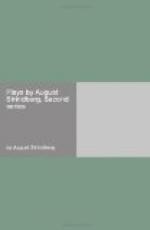Turning to the technical side of the composition, I have tried to abolish the division into acts. And I have done so because I have come to fear that our decreasing capacity for illusion might be unfavourably affected by intermissions during which the spectator would have time to reflect and to get away from the suggestive influence of the author-hypnotist. My play will probably last an hour and a half, and as it is possible to listen that length of time, or longer, to a lecture, a sermon, or a debate, I have imagined that a theatrical performance could not become fatiguing in the same time. As early as 1872, in one of my first dramatic experiments, “The Outlaw,” I tried the same concentrated form, but with scant success. The play was written in five acts and wholly completed when I became aware of the restless, scattered effect it produced. Then I burned it, and out of the ashes rose a single, well-built act, covering fifty printed pages, and taking hour for its performance. Thus the form of the present play is not new, but it seems to be my own, and changing aesthetical conventions may possibly make it timely.
My hope is still for a public educated to the point where it can sit through a whole-evening performance in a single act. But that point cannot be reached without a great deal of experimentation. In the meantime I have resorted to three art forms that are to provide resting-places for the public and the actors, without letting the public escape from the illusion induced. All these forms are subsidiary to the drama. They are the monologue, the pantomime, and the dance, all of them belonging originally to the tragedy of classical antiquity. For the monologue has sprung from the monody, and the chorus has developed into the ballet.
Our realists have excommunicated the monologue as improbable, but if I can lay a proper basis for it, I can also make it seem probable, and then I can use it to good advantage. It is probable, for instance, that a speaker may walk back and forth in his room practising his speech aloud; it is probable that an actor may read through his part aloud, that a servant-girl may talk to her cat, that a mother may prattle to her child, that an old spinster may chatter to her parrot, that a person may talk in his sleep. And in order that the actor for once may have a chance to work independently, and to be free for a moment from the author’s pointer, it is better that the monologues be not written out, but just indicated. As it matters comparatively little what is said to the parrot or the cat, or in one’s sleep—because it cannot influence the action—it is possible that a gifted actor, carried away by the situation and the mood of the occasion, may improvise such matters better than they could be written by the author, who cannot figure out in advance how much may be said, and how long the talk may last, without waking the public out of their illusions.
It is well known that, on certain stages, the Italian theatre has returned to improvisation and thereby produced creative actors— who, however, must follow the author’s suggestions—and this may be counted a step forward, or even the beginning of a new art form that might well be called productive.




